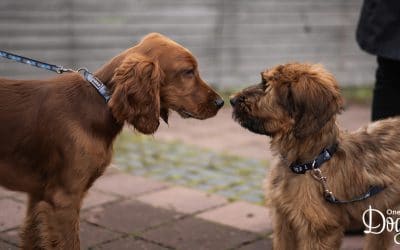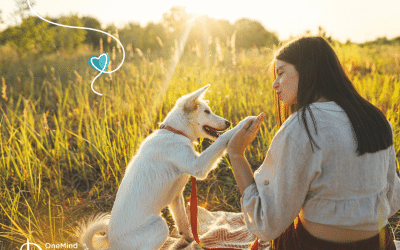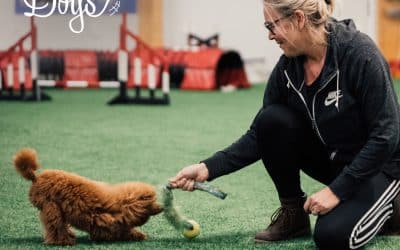The OneMind Dogs method is built on the idea that close bonds start with owners understanding their dogs. Building a magical connection with your German Shepherd takes empathy, patience, and a keen eye for the non-verbal cues dogs communicate with. Naturally, this applies to training all dogs, especially those highly intelligent breeds that need plenty of stimulation.
In this guide, we’ll explore all the key points for training German Shepherd Dogs. We’ll break down how they interact with the world, why this is important to know, and how to work with this perspective for the best results.
Understanding your German Shepherd’s perspective
While every dog has a unique personality, people often talk about specific breeds with blanket terms. German Shepherds have a reputation for being smart, loyal, confident, versatile, and capable, but that doesn’t tell us much about individual dogs. Even if these are all shared traits, they don’t account for the things that matter most: preferences, behavior and perspective.
For OneMind Dogs Assistant Coach, Attila Varga, it’s all about knowing the individual:
“When I get a new dog, the most important thing is to find out as much about him as possible; what is the best reward for him, what does he like and dislikes, and so forth.”
Understanding the dog’s perspective shows us the best way to approach their training. Two German Shepherds can be equally fast learners but have different learning styles. One may prefer to think through a task while the other prefers jumping in head first.
If we teach, challenge, and reward them the same way, they won’t progress at the same rate. One dog will struggle more because the session isn’t set up to help them succeed.
Setting the dog up for success in training
So, what does it mean to set up for success? Well, when it comes to training your German Shepherd Dog, three things:
- Timing
- Rewards
- Routine
Let’s start with timing. When you train matters as much as how you train. Choose a time of day when your dog is likely to be motivated, focused, and eager. A motivated puppy will pay more attention and have an easier time following cues. Training just before mealtime is great because then mealtime becomes a reward.
Rewards also encourage dogs to focus and listen. Food is a strong motivator, but if you don’t want to rely on mealtime, toys work just as well. Try lots of different toys — hard, soft, noisy, bouncy, crinkly etc. Once you discover your puppy’s favorite toy and play style, you can use it during training sessions as a motivator.
Stocking up on new ones doesn’t have to be expensive, either. Make the family part of the fun and DIY safe puppy toys at home!
If rewards are how you finish strong, routine is what gives you momentum going into training. When sessions start at the same time every day, dogs know what to expect, and when. If it’s just before mealtime, training becomes a precursor to something they value. Likewise, late afternoon sessions can help energetic puppies wind down for the evening and sleep soundly.
Once you know when training is most beneficial for your dog, it’s just about being consistent.
Preventing problems before they begin
Even after attending puppy school with your German Shepherd, certain issues can come up and derail your dog’s progress. Luckily, there’s a way to prevent each one from even starting. The most common training mistakes new owners make are:
- Setting expectations that dogs don’t understand
- Not looking for alternatives when things don’t work
- Only reacting to setbacks
So, what’s the root of these problems and what can we do to nip them in the bud? Ultimately, each one comes back to not understanding the dog’s perspective.
We set expectations for goals we want to achieve, but that’s not how puppies or older pets think. Dogs have their own language, and they get frustrated when we don’t listen either. Knowing what they value tells us what motivates them. We can use this to communicate things more intuitively.
This also applies when trying to teach your dog new commands. Words like “sit” and “come here” make sense to us because that’s the language we use. We associate those words with specific actions, but our dogs don’t, until we teach them.
For a puppy, the word “sit” only means something once they associate the sound with a behavior. This means we need to help them connect the verbal command to the act of putting their bum on the floor. If they don’t respond at first, it doesn’t mean your dog is stubborn. They just don’t understand yet!
Not every puppy will follow the same path to that connection, so you’ll need alternative cues to guide them. Being flexible will keep you from getting frustrated and your puppy from feeling overwhelmed.
How we respond has a huge impact on the success of any training session. If you only react to your German Shepherd’s undesireable behaviors, chances are that you won’t stop them from happening. Negative attention can even reinforce the habit you’re trying to curb. We focus on positive reinforcement because it rewards a job well done, and uses healthy alternatives to replace bad manners. Plus dogs respond much better, learn faster and trust you more in the long run!
Teaching your German Shepherd to chill out alone
Boundaries are the key to a happy home for every family, and the same is true when bringing a new pet into yours. The earlier they learn about expectations for being in a space, the quicker they’ll settle.
Spacial boundaries range from having a safe nook where they chill out to staying calm when visitors come over. Teaching your dog how to be comfortable when they’re left alone will protect them from the stress of separation anxiety. This is true whether you work away from the house or in a home office where you don’t want distractions.
Giving your dog a safe space to chill alone will help them get used to their own company. It can teach them to disengage when they feel overwhelmed by their surroundings, which can happen when there’s more commotion than normal, other dogs, or during thunderstorms. Our unique puppy training app contains professional, step-by-step lessons on setting your dog up for success with chilling out (and many other important life-skills), entirely from your dog’s perspective.
If you’ve ever had furniture used as a chew toy, you’ll know how important it is to help puppies regulate stress. If they feel safe, happy, and assured when they’re alone, they’ll grow into confident dogs with healthy attitudes while sparing your couches in the long run!
Mental stimulation — the key to a happy dog
Whether it’s elite agility training or puppyhood 101, physical and mental stimulation go hand in hand.
Running an obstacle course and other physical exercises teaches dogs to use their bodies, improves balance, and supports their growth. Mental stimulation, on the other hand, improves their focus, regulates emotions, and strengthens the magical bond they share with you.
Training that engages their minds as much as their bodies will lead to better results. It helps your dog stay on task, even in a disruptive environment. Other dogs in the park, street noises, and crowds in competitive settings are all distractions that tug at a dog’s attention.
Using their brains to solve problems builds confidence by engaging all the tools they need in everyday life. Success here is about pairing fitness and focus. Exercises that do both are more tiring and rewarding, and it doesn’t take a lot to balance the two. It’s something you can do on a normal walk.
OneMind Dogs Foundation for Agility has some great tips to keep daily walks fun, exciting, and mentally stimulating. You can even hide the DIY puppy toys as part of a game to get their noses working. There’s no better treat at the end of a treasure hunt!
Get more tips and fun challenges to do with your German shepherd Dog, join our FREE Magical Connection Week Challenge by filling out the form below:



